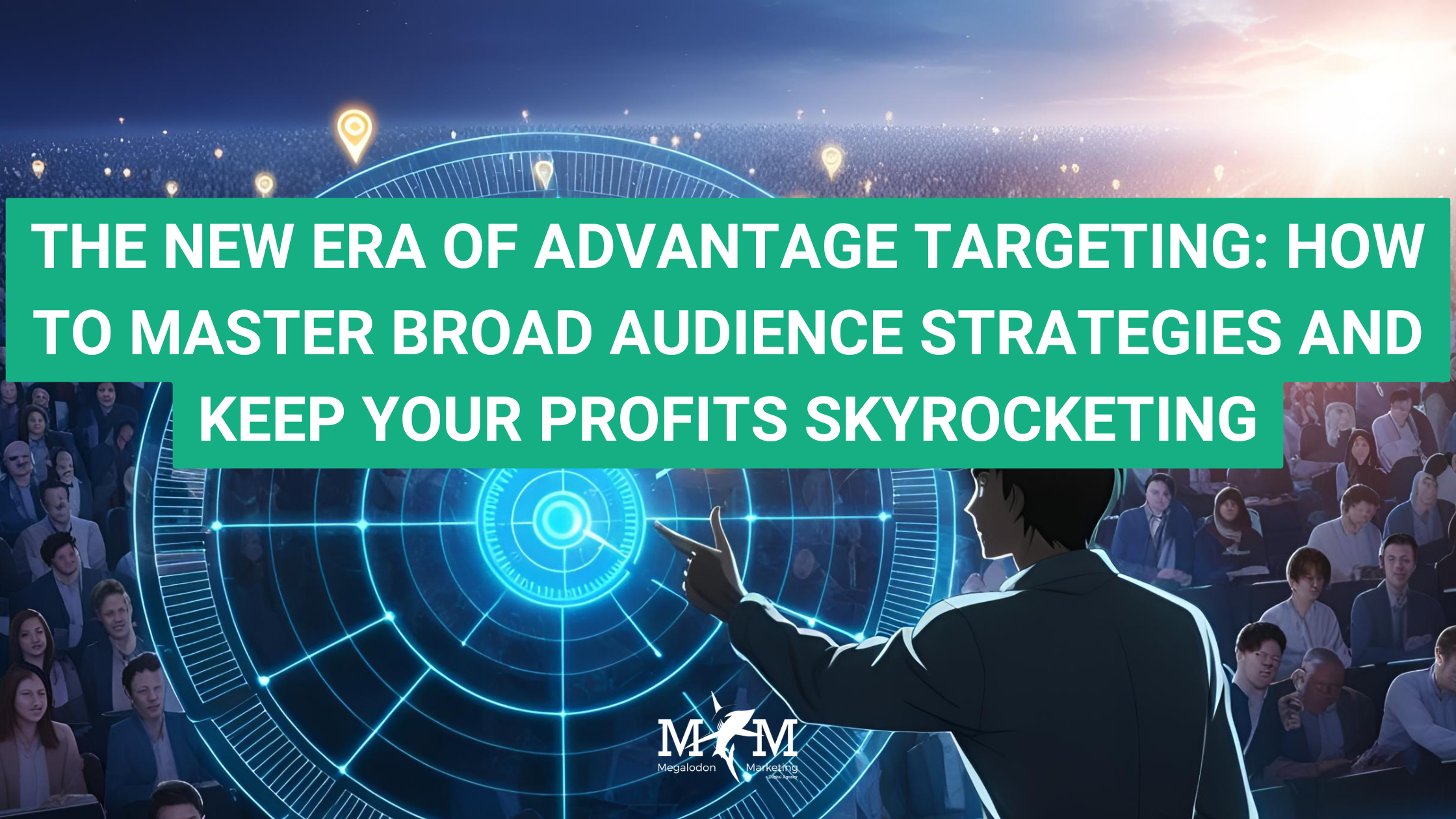I hope you enjoy reading this blog post. If you want my team to just do your marketing for you, click here.

I hope you enjoy reading this blog post. If you want my team to just do your marketing for you, click here.
Author: Jeremy Haynes | founder of Megalodon Marketing.

Earnings Disclaimer: You have a .1% probability of hitting million dollar months according to the US Bureau of Labor Statistics. As stated by law, we can not and do not make any guarantees about your own ability to get results or earn any money with our ideas, information, programs or strategies. We don’t know you and, besides, your results in life are up to you. We’re here to help by giving you our greatest strategies to move you forward, faster. However, nothing on this page or any of our websites or emails is a promise or guarantee of future earnings. Any financial numbers referenced here, or on any of our sites or emails, are simply estimates or projections or past results, and should not be considered exact, actual or as a promise of potential earnings – all numbers are illustrative only.
Watch the full video breakdown on this topic here.
When you log into your Meta Ads Manager these days, there’s a chance your carefully crafted interest stacks have been stealthily swapped out for something brand new—something called “Advantage audience” targeting. If you’re like many of the top-performing advertisers I’ve worked with over the years, this shift can feel like your hard-earned system has been hijacked overnight. But here’s the cold, hard truth: this isn’t the enemy—it’s a signal that it’s time to adapt and evolve.
I’ve built successful campaigns with over 40 of the top million-dollar-a-month earners, and if there’s one lesson I’ve learned from all those years of hustling in digital advertising, it’s that change is the only constant. And right now, Meta is forcing our hand by rolling out Advantage Targeting, effectively defaulting our ad sets to broad targeting. Whether you like it or not, this new reality means that the only way to stay profitable is to reinvent your strategy from the ground up. In this post, I’m going to share with you every single detail from my recent research and hands-on experiments with this change—from pixel conditioning to messaging tactics—so you can keep your edge and thrive, no matter how the landscape shifts.
In the past few months, many advertisers have seen their accounts default to what Meta calls “Advantage detailed targeting.” This isn’t just a new label—it’s a fundamental change in how Meta thinks about audience selection. If your traditional niche was razor-sharp—say, targeting a group of 10,000 to 30,000 people—this forced broad targeting can initially feel like a disaster. Your meticulously tested interest stacks or lookalike audiences might suddenly vanish, replaced by a vast, almost indiscriminate reach.
Here’s the kicker: meta testing is rolling this out gradually. Some accounts are already experiencing a complete default to broad targeting on the ad set level, leaving you with no option to revert back to your old, hyper-targeted setups. This automatic expansion means that even warm audiences have to be reined in or risk being expanded too broadly—potentially diluting the quality of traffic and skyrocketing your customer acquisition costs.
But don’t panic—this isn’t a death sentence. It’s a call to refine your process and master new tactics that take advantage of Meta’s ever-improving AI. Instead of mourning the loss of your traditional detailed targeting, this is the perfect opportunity to leverage what’s coming as a competitive edge. Once you understand the mechanics behind broad targeting and how to feed the algorithm the right signals, you can actually surpass the old performance metrics. And that all starts with a deep dive into pixel conditioning.
If there’s one element that has taken on newfound importance in our evolving landscape, it’s pixel conditioning. Here’s the deal: the initial conversions—often the very first two to five hits on your pixel—are the ones that set the stage for who Meta deems most valuable in your target audience. Historically, it might have taken 20, 50, or even 100 conversions for the algorithm to start locking in on your ideal customer profile. But under the current Advantage Targeting framework, those early conversions are dramatically more influential.
Think about it: if the first few conversions are from low-quality leads—secret shoppers, fake leads, or non-serious buyers—the algorithm immediately starts chasing more of the same, skewing your results in the wrong direction. That’s why I always tell my clients: conditioning your pixel is not optional—it’s the cornerstone of your entire campaign.
By controlling and conditioning your pixel, you can indirectly control the future trajectory of your campaigns. This means that even though you’re being forced into a broad targeting situation, you’re still telling Meta’s AI exactly which type of customer to go after—and that can lead to dramatically lower costs per conversion and a significantly higher return on ad spend.
In this new landscape, the art of gating becomes indispensable. Gating allows you to “filter” who fires your pixel, ensuring that only your ideal customers are sending the right signals back to Meta. This is crucial whether you’re running opt-in funnels, call funnels, or direct purchase funnels. Now, let’s break down these gating mechanisms in detail.
Imagine you’re running an opt-in campaign—maybe a free webinar, a challenge, or a lead magnet. In the past, you might have relied on finely tuned interest stacks to attract the right leads, but with Advantage Targeting, you need an additional layer of protection.
How to Do It:
Result: You capture a smaller but much more qualified pool of leads. The algorithm learns quickly from these high-quality signals, setting your campaign up for long-term success.
When your funnel is designed to land a call—whether it’s for high-ticket coaching, a strategy session, or a consult—the stakes are even higher. You’re not just after a sign-up; you need serious prospects who can pay serious money.
How to Do It:
Result: Although your total number of leads might decrease, you dramatically increase the quality of those leads. The pixel fires only for the type of customer who has the financial capacity and seriousness to invest, thus sharpening the algorithm’s future targeting.
For those of you who run direct sales funnels, especially with upsell paths, gating doesn’t stop at the lead phase—it extends into the purchase process. Let’s consider a scenario where your funnel includes an initial ticket sale, followed by one or more upsells.
How to Do It:
Result: By sending only the top-tier conversions back to your pixel, you ensure that Meta’s algorithm doubles down on the high-value audience. This increases the probability of future conversions coming from those who are more willing to invest in your higher-ticket offers.
For e-commerce entrepreneurs selling high-ticket items—think products with price points ranging from $10,000 to $100,000—the challenge is similar. You don’t want your pixel filled with low-intent buyers who might purchase on a whim. You need your algorithm conditioned by high-ticket purchases.
How to Do It:
Result: High-value data flowing into your pixel trains Meta’s algorithms to replicate your most profitable customer profile, ensuring that future ad spend is targeted at prospects who are financially capable and ready to buy.
In this era of broad targeting, your messaging isn’t just important—it’s the linchpin of your entire strategy. It’s what differentiates you from the noise, filters out the unqualified, and communicates exactly who your product or service is for.
You might think, “I can just use generic, buzzword-filled ad copy,” but here’s the uncomfortable truth: Meta’s AI is smarter than ever. It reads your headlines, your primary text, and even text within your images. It associates every word you use with the audience you want.
Simple, vague language often attracts everyone—but that’s the worst-case scenario when you’re dealing with broad targeting. If you aren’t crystal clear about who your offer is for, you’ll end up attracting a large pool of low-intent individuals who can dilute your campaign performance and misguide the algorithm. By being ultra-specific, you not only signal to the algorithm who to focus on but also empower your ideal customers to self-select into your funnel. And trust me, that self-selection is what makes all the difference in long-term scalability.
For a long time, many advertisers enjoyed a cozy niche with warm audiences—those who had already engaged with your brand organically. However, when forced into broad targeting, many advertisers suddenly face the challenge of engaging with truly cold audiences. And let me tell you, cold audiences demand a different level of expertise.
By embracing these strategies, you transform forced broad targeting from a limitation into an opportunity to build a much larger, more scalable customer base—all while maintaining profitability.
There’s an unavoidable reality when dealing with broad targeting and cold audiences: conversions may cost more initially. You may need to adjust your financial model to account for the slower ramp-up and potentially higher cost per acquisition. However, the upside is significant if you get it right.
By refining your financial model, you ensure that every dollar spent on broad targeting is an investment toward a sustainably scalable marketing strategy.
Here’s the bottom line: Meta’s forced roll-out of Advantage Targeting may feel like a disruption—but it’s also an unprecedented opportunity. By mastering the techniques of pixel conditioning, gating, and precise messaging, you can not only maintain profitability but actually scale your business to new heights.
There’s an important lesson in every platform update. Meta’s shift to Advantage Targeting is simply the latest evolution in a long line of changes in digital advertising. History has shown that those who react quickly—those who refine their strategies and invest in new methods—always come out on top. In my experience, the advertisers who remain profitable aren’t the ones who cling to outdated strategies; they’re the ones who pivot, test relentlessly, and harness the power of data-driven insights.
By understanding the intricacies of pixel conditioning and how to effectively gate your audiences, you empower your campaigns. You turn every forced broad targeting scenario into an opportunity to attract an even larger, more profitable audience than before. And remember: while the early signals provided by your pixel are fleeting, they are the blueprints that determine every future impression, click, and conversion. Get them right, and you’ll open the floodgates to a whole new level of performance.
Meta’s algorithms are evolving rapidly—and so should you. Embrace the tools at your disposal, experiment relentlessly, and don’t be afraid to adjust tactics when necessary. The future belongs to those who are willing to push the boundaries of traditional targeting, who can articulate their value with precision, and who are prepared to chase cold leads with a renewed strategy that yields warm profits.
In summary, here’s what we’ve dissected today:
If you’re willing to make these strategic shifts today, you’re not just surviving—you’re positioning yourself to thrive. The landscape may be changing, but those who adapt with speed, intelligence, and precision will be the ones who pull ahead of the competition.
As you integrate these practices, remember that adaptation is the name of the game. Test new gating questions, monitor your pixel’s performance, and double down on the messaging that resonates with your high-value audience. Consider every change in Meta’s targeting options as a chance to refine your approach further and emerge more profitable than ever.
To wrap it up: When you start feeding your pixel only the best signals, when your messaging speaks directly to the customer you want, and when you master the art of nurturing cold leads, you’re no longer at the mercy of the algorithm—you’re in control. That’s how you turn a disruptive update into your greatest competitive advantage.
Now, go ahead—restructure your funnels, sharpen your copy, and embrace the new era of Advantage Targeting with confidence. The future is wide open for those who dare to pivot.
Final Word
Change in digital advertising is inevitable. Whether it’s an update from Meta or a new competitor on the horizon, the essence of success remains the same: adaptability, precision, and unwavering focus on your customer’s journey. I’ve seen it happen time and time again—those who cling to old habits end up spending money on outdated strategies, while those who innovate see results that set them apart.
I challenge you today to take everything we’ve discussed, implement these tactics, and watch as your campaigns not only adjust to broad targeting but thrive under it. Remember, the best advertisers aren’t those who simply follow the rules—they’re the ones who rewrite them. Adapt, refine, and never stop pushing the boundaries of what’s possible in paid advertising.
Now is the time to master this new era. Go forth, implement these insights, and keep breaking through those revenue ceilings. Your next big breakthrough is waiting on the other side of adaptation—and I promise you, it’s going to be worth every moment of testing and refining.

Jeremy Haynes is the founder of Megalodon Marketing. He is considered one of the top digital marketers and has the results to back it up. Jeremy has consistently demonstrated his expertise whether it be through his content advertising “propaganda” strategies that are originated by him, as well as his funnel and direct response marketing strategies. He’s trusted by the biggest names in the industries his agency works in and by over 4,000+ paid students that learn how to become better digital marketers and agency owners through his education products.

Jeremy Haynes is the founder of Megalodon Marketing. He is considered one of the top digital marketers and has the results to back it up. Jeremy has consistently demonstrated his expertise whether it be through his content advertising “propaganda” strategies that are originated by him, as well as his funnel and direct response marketing strategies. He’s trusted by the biggest names in the industries his agency works in and by over 4,000+ paid students that learn how to become better digital marketers and agency owners through his education products.
This site is not a part of the Facebook website or Facebook Inc.
This site is NOT /endorsed by Facebook in any way. FACEBOOK is a trademark of FACEBOOK, Inc.
We don’t believe in get-rich-quick programs or short cuts. We believe in hard work, adding value and serving others. And that’s what our programs and information we share are designed to help you do. As stated by law, we can not and do not make any guarantees about your own ability to get results or earn any money with our ideas, information, programs or strategies. We don’t know you and, besides, your results in life are up to you. Agreed? We’re here to help by giving you our greatest strategies to move you forward, faster. However, nothing on this page or any of our websites or emails is a promise or guarantee of future earnings. Any financial numbers referenced here, or on any of our sites or emails, are simply estimates or projections or past results, and should not be considered exact, actual or as a promise of potential earnings – all numbers are illustrative only.
Results may vary and testimonials are not claimed to represent typical results. All testimonials are real. These results are meant as a showcase of what the best, most motivated and driven clients have done and should not be taken as average or typical results.
You should perform your own due diligence and use your own best judgment prior to making any investment decision pertaining to your business. By virtue of visiting this site or interacting with any portion of this site, you agree that you’re fully responsible for the investments you make and any outcomes that may result.
Do you have questions? Please email [email protected]
Call or Text (305) 704-0094